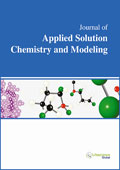jascm
Abstract : Modeling and Molecular Spectroscopic Analyses of Cellulose
|
|
Abstract: Cellulose is the most abundant biopolymer which is a topic of extensive research work. In this study Fourier Transform Infrared Spectroscopy (FTIR) was utilized to assign the molecular structure of cellulose. B3LYP at 3-21g**, 6-31g** and LANL1DZ then MP2 at 6-31g* levels of theories were conducted to compare the calculated vibrational spectra with the FTIR spectrum. Model molecules of cellulose starting with monomer up to cellulose 18 units were studied with PM3 semiemperical method in order to follow up the effect of polymerization upon some selected physical parameters. Results indicate that final heat of formation and band gap energy have decreased with increasing cellulose units while total dipole moment has increased with increasing cellulose units. It is concluded that the reactivity of cellulose has increased with increasing the units also the unique hydrogen bonding dedicates cellulose to several applications. Keywords: Cellulose, FTIR, PM3, DFT and Physical propertie.Download Full Article |
Abstract : Solubility Prediction of Paracetamol in N-Methyl-2-pyrrolidone + Ethanol + Water Mixtures at 25 °C
|
|
Abstract: The solubility of paracetamol in N-Methyl-2-pyrrolidone (NMP) + ethanol and NMP + ethanol + water solvent mixtures at 25 °C was determined using the shake flask method. The generated data extended the solubility database of pharmaceuticals and also was used to assess the solubility prediction capability of the Jouyban-Acree model in NMP + ethanol + water mixtures. The accuracy of the predicted solubilities was evaluated by the mean percentage deviation (MPD) between the predicted and experimental solubilities. The MPD of the Jouyban-Acree model for predicting the solubility of paracetamol in NMP + ethanol + water mixtures at 25 °C was 14.6 %. Keywords: Paracetamol, binary solvents, ternary solvents, solubility prediction, pharmaceutical cosolvents.Download Full Article |
Abstract : Synthesis and Characterization of N-Substituted Tetrahydroiso-quinoline Derivatives via a Pictet-Spengler Condensation
|
|
Abstract: Synthesis of N-substituted 1,2,3,4 –tetrahydroisoquinoline derivatives and bis-isoquinoline has been carried out via a Pictet-Spengler condensation. Tetrahydroisoquinolines were obtained from 2-(3’,4’-dimethoxyphenyl) ethylamine in four steps. The entire synthesized compounds were characterized by IR, 1H NMR and mass spectral data. Keywords: Tetrahydroisoquinoline, Pictet-Spengler reaction, Imine, Trifluoroacetic acid.Download Full Article |
Abstract : Surfactant Assisted Synthesis of Homogeneous Calcium Based CO2 Sorbent at Room Temperature
|
|
Abstract: Calcium oxide (CaO) sorbents have been recently used for removal of CO2 gases in fossil fuel-fired power plant. However, there are some limitations of CaO in CO2 capturing such as rapid loss of activity during the capture cycles, which is a result of sintering, attrition, and consequent elutriation. Therefore, this paper has demonstrated a novel synthesis method to produce CaO at room temperature to avoid abovementioned drawbacks. In addition, introduction of ionic surfactant of sodium dodecyl sulfate to the CaO formation solution has shown a positive result of formation of homogeneous spherical particle with a mean Z-average diameter of 345.2 nm and polydispersion index (PDI) of 0.335 by dynamical light scattering measurement. Subjected to a high calcination temperature of 1200oC, developed CaO is able to maintain a CO2 uptake capacity of 0.1025 gCO2/gsorbent under 30 minutes of carbonation time. Despite its lower CO2 uptake capacity compared to maximum theoretical limit of 0.78 gCO2/gsorbent, CaO particles is able to withstand a high calcination temperature of 1200oC and reported a particle size distribution ranged from 0.4 - 1.2µm after calcination which is just slightly larger than fresh developed CaO. Given that such small narrow distributed size of CaO, developed CaO at room temperature is good for packed-bed reactor in calcium looping processes and more studies are required to find a suitable support for fluidized bed reactor type. This successful synthesis story of CaO particle at room temperature has unraveled the possibility to develop nanosized CaO at room temperature in order to achieve high CO2 uptake capacity while enjoying its superior thermal stability over multiple carbonation/calcination cycles. . Keywords: Calcium oxide, carbon capture, high temperature reaction, next generation CO2 sorbent, thermal stability.Download Full Article |






















